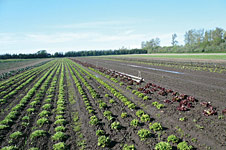 |
 One important rule in organic farming is to change a crop's location every year. This is called crop rotation. Planting the same crops in the same place year after year will make the soil lose its nutrients and structure, causing erosion, and encourage pest populations that feed on that crop to increase. One important rule in organic farming is to change a crop's location every year. This is called crop rotation. Planting the same crops in the same place year after year will make the soil lose its nutrients and structure, causing erosion, and encourage pest populations that feed on that crop to increase.
In an effective system of crop rotation, different classes of plants follow each other. Each crop requires different things from the soil, so the soil is not readily depleted. Rotating crops that have dry cycles, such as grains, with crops that have wet cycles, like veggies, decreases pests and fungi populations.
A typical crop rotation might be a brassicae followed by a grain, then a hay or cover crop followed by carrots. Carrots can only be planted in one place one year out of four to avoid the carrot rust fly that survives in the soil, waiting for the carrots to come back. The grain and the hay starve them out. Spinach can follow the carrots, then another brassicae, then more grain, etc.
|





